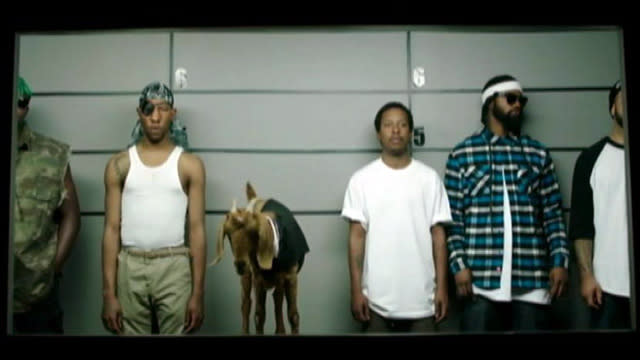What’s Behind the Recent String of Tasteless, Offensive Ads?
One company after the next has been making public apologies lately for putting out highly offensive – even racist – ad campaigns. They’ve left consumers and marketing pros scratching their heads, wondering what the likes of Pepsi (PEP), GM (GM) and Hyundai were thinking.
The latest controversy to inspire a corporate apology was a 60-second online commercial for Mountain Dew, which is produced and owned by PepsiCo. The absurdist spot features a battered white woman on crutches in a police station trying to pick a suspect out of a lineup of black men. A talking goat named Felicia is also in the lineup, makes threatening remarks to her – “Keep your mouth shut” and “snitches get stitches” – until the woman runs out of the room hysterically screaming. The ad was criticized for portraying racial stereotypes and downplaying violence against women.
According to a report on Billboard.com, a PepsiCo spokeswoman said the company was made aware on Tuesday that some people found the ad offensive. Pepsi pulled the spot, which was developed by rapper Tyler, the Creator, and the company issued an apology.
On Wednesday Mountain Dew tweeted: “Hey guys - made a big mistake we've removed the offensive video from all our channels. #fail.”
A string of controversies
Several other companies have been the focus of similar controversy in just the past couple of months. General Motors stirred up some trouble this week with its ad for Chevrolet’s Trax SUV that featured a song some said was offensive to Asians. The ad features vocals from a 1938 recording which refers to China as "the land of Fu Manchu" where people say "ching ching, chop suey." The spot was part of a global ad campaign for the new car, and had been running in Canada, according to the South China Morning Post, which called the ad racist.
An apology ensued and the ad has been withdrawn: "Our intent was not to offend anyone and we're deeply sorry if anyone was offended… We're reviewing our advertising approval processes to make sure this doesn't happen again,” a Detroit-based GM spokeswoman told Ad Age. The ad can still be seen here on YouTube.
In April Hyundai got caught in a flap for an ad touting its hydrogen-powered car, which it pulled. It featured a man trying to asphyxiate himself from his car's exhaust; he realizes he can’t after discovering the car is a zero-emission vehicle. Hyundai Motor and Innocean, the firm that created the spot, apologized “for any offense or distress" the ad caused. (The commercial couldn't be found on YouTube as of Thursday.)
Ford Motor (F) also felt the fallout from controversial Indian poster advertisements that included one depicting women tied up and gagged in the trunk of a Ford Figo driven by ex-Italian Prime Minister Silvio Berlusconi. (JWT India, a unit of the largest global advertising group WPP, produced the ads.)
Are the firms really this clueless?
What’s behind this series of PR faux pas? Could these brand-name firms really be that clueless about how a mass audience might view their campaigns?
One possibility, says Ronald Goodstein, an associate professor of marketing at Georgetown University, is that these ads weren’t tested in the proper way. The ad agency and company staff might think the spot is funny, but they don't represent the customer. And in the case of car makers, which seem especially prone to ad gaffes lately, Goodstein says the problem can be sourced to a kind of cultural divide. These companies are “acting outside of their home countries, and are not as sensitive to the cultural differences in places where they sell as they are to their home issues,” he says.
“They do a theater setting and test the ad with a bunch of people, but they’re not showing it to groups represented in the ad,” Goodstein says. “If you’re going to use humor, you need to relate it to what you’re selling,” which the Mountain Dew and GM ads don’t do. The Hyundai spot does that “but it doesn’t work – it’s tasteless,” Goodstein says.
Another possible disconnect is that firms target their message to a certain slice of consumers, but when the message spills over to other segments – which it’s bound to do with social media’s immediacy – people get offended, says Z. John Zhang, a marketing professor at the University of Pennsylvania’s Wharton School. “Advertisers should become more aware that messages are harder to target today,” he says.
McDonald’s (MCD) made a similarly misguided move last month in an ad that ran on Massachusetts Bay Transportation Authority subway trains. It featured a photo of a distraught woman, holding her head in her hand. The headline read: "You're not alone," and the small print underneath says, "Millions of people love the Big Mac." Some thought the ad, which is reminiscent of one for a crisis center, seemed to make light of mental illness. It’s possible the company did test the ad, and that some people just viewed the woman in the ad as upset, Goodstein says, “but they didn’t think about how it could be seen as someone suffering from mental health issues.” (According to an article on Time's site, the ad was not approved by McDonald’s and the company asked it be taken down, a spokesperson said.)
"The underlying goal for these ad campaigns seems to be a quest for edginess, but they come off looking like a desperate attempt for relevance,” says Peter Dixon, senior partner and creative director at Prophet, a strategic marketing and branding consultancy.
The Mountain Dew spot, Dixon adds, “is completely over the top. It actively uses stereotypes as a central part of the spot, which is just plain stupid.”

